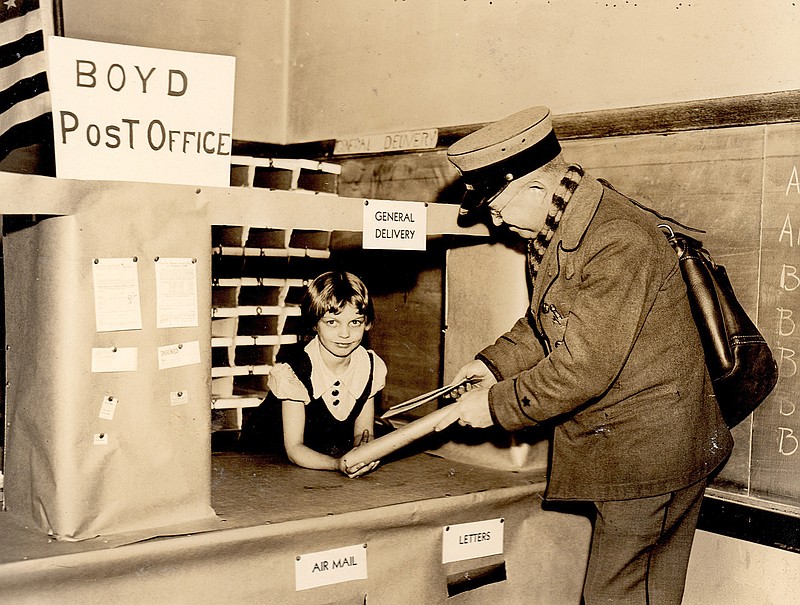A group of Purple Heart recipients used to meet for breakfast monthly at a Veterans of Foreign Wars post in Springfield, enjoying a meal and fellowship. During one of these informal gatherings, U.S. Marine Corps veteran Bryce Lockwood was handed a package by a member of the post containing photographs and documents. Lockwood was advised it had been left by an individual who believed the materials were of some importance and should not be discarded.
The package contained information regarding two local veterans - one who, after being drafted in World War I, saw combat in France with a field artillery battery and, years later, witnessed the introduction of airmail service to the Springfield area while serving as a mail carrier.
Walter Penry Chalender, according to his draft registration card, was born and raised in Wellsville, Kansas, but owned and operated his own farm near Springfield when he registered for the military draft June 5, 1917. Three months later, the 22-year-old was drafted into the U.S. Army and assigned to the 342nd Field Artillery.
"The 342nd Field Artillery was organized September 5, 1917, at Camp Funston, Kansas," explained Robert Chubb, regimental historian, in the 1921 book "Regimental History 342nd Field Artillery, 89th Division." He added, "The regiment was recruited from the first draft of men from Green(e), Polk, Dallas, Stone, Bollinger, and Laclede counties of southern Missouri-men for the most part from farms and rural communities."
For months, the newly formed regiment trained at the Kansas military post, learning such skills as the construction of divisional trench systems similar to those being used in France. They performed road marches around scrap piles of lumber while witnessing new barracks spring up across the surrounding prairie to house scores of fresh draftees being inducted into the military.
The regimental historian explained that in April 1918, the regiment began more intense training and practice "on the target range; first with the three-inch guns and later with 4.7 (inch) howitzers." He also noted the regiment was broken down into six batteries and two companies, leaving "Camp Funston on June 3rd, 1918, considerably below strength, having contributed an average of 100 men a month to replacement detachments."
Records accessible through the Missouri State Archives reveal Chalender departed for overseas service, along with his fellow soldiers of the regiment, on June 28, 1918. Following their arrival overseas, they trained for several weeks in France and received a battery of 1915 Schneider 155mm howitzers to use in combat.
They entered service on the front lines during the third week of September 1918, suffering four casualties in Battery D when German shells struck their lines on the the twenty-first. Eventually, the regimental historian explained, "the regiment began to settle down to the routine of firing at night and working during the day, sleeping between times."
The batteries of the regiment supported infantry along the Hindenburg Line, pounding with their deadly howitzer shells German targets such as command posts and machine gun emplacements.
After the armistice, which occurred at 11 a.m. Nov. 11, 1918, many of the former enemies met in a friendly fashion on the former front lines of the war, which, the regimental historian wrote, was followed by a "general celebration signalized by thousands of rockets and flares."
Chalender remained in Germany for the next several months assigned to the regimental headquarters while they performed duties as part of the occupational forces. He received a promotion to the rank of "color sergeant" in March 1919, having the responsibility for carrying the regimental colors (guidon, standard or flag).
The soldier returned to the states in early June 1919, receiving his discharge and working as a stenographer for a local grocery store. In 1920, he married the former Agnes Rainey, and the couple raised two daughters. As the years passed, the WWI veteran was hired by the U.S. Postal Service and was employed many years as a letter carrier.
A highlight of his postal career came more than a decade following his military service. As the Springfield Leader reported Oct. 28, 1930, "transcontinental air mail and passenger service became a reality Saturday." Chalender, a member of the Springfield post office band, helped celebrate "the opening of the Transcontintental-Western Airline with rousing music."
To capture the historic moment, Chalender mailed his youngest daughter, 8-year-old Anetta June, a letter with an envelope marked with a postal stamp celebrating the momentous occasion. On a paper yellowed with age found inside the envelope, he wrote, "Greetings from your father on our first Air Mail flight, Oct. 25, 1930."
The veteran and his wife continued to live and work in the community of Springfield. Sadly, his 67-year-old wife passed away from complications related to cancer March 8, 1968; Chalender passed away five years later and lies next to his wife in Springfield's Hazelwood Cemetery.
Why many of Chalender's personal effects and documentation were given to the VFW remain something of a mystery, but as Lockwood noted upon receiving the package, he recognized the items represented a unique parallel to another Missouri WWI veteran.
"My understanding is that it may have been a member of the family that brought it to the VFW post because it didn't hold a great deal of importance for them, but they realized it was of some military historical significance," Lockwood said.
"And what makes it even more interesting," he added, "is that (Chalender) was a man from Missouri who served in WWI with a field artillery battery." With a grin, he concluded, "I seem to remember another young man from Missouri who served with the field artillery in WWI and went on to become president - Harry S Truman!"
Jeremy P. mick writes on behalf of the Silver Star Families of America.

